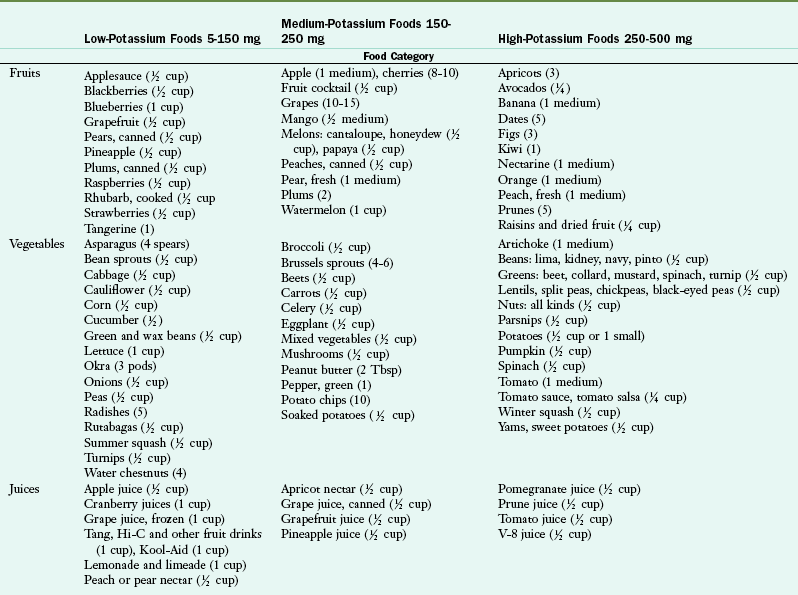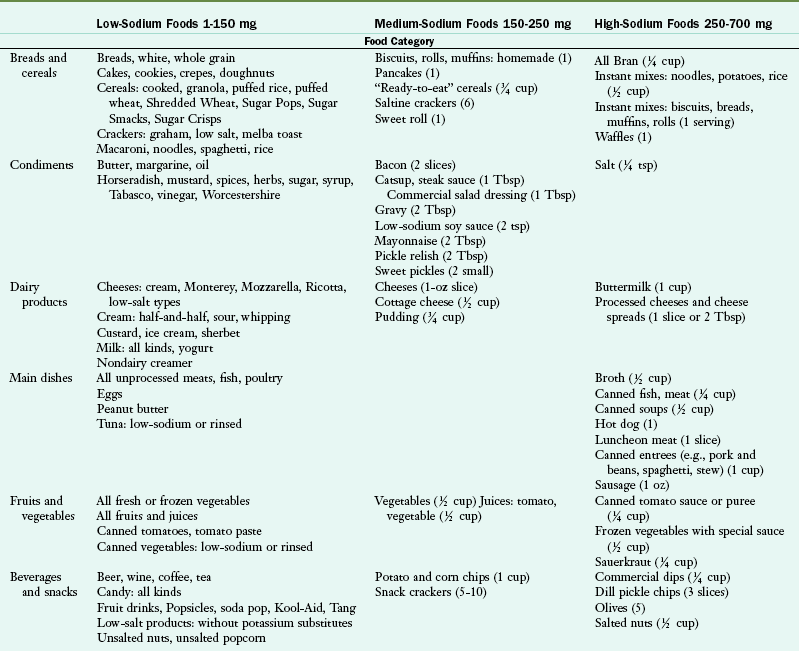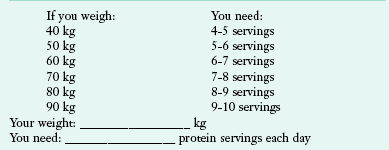Renal Diet for Dialysis
Your diet depends on your kidney function. Most of the information here relates to people on dialysis. What is right for others is not always right for you. As your kidney function changes, your diet may change as well. This guide will help you do two things: plan nutritious meals you enjoy and keep your body working at its best. Your renal dietitian will work with you to make any changes needed to your usual meal plan, but this appendix contains helpful guidelines.
You will need to eat a high-protein diet. Beef, pork, lamb, fish, shellfish, chicken, eggs, and other animal foods provide most of the protein in your diet. Your protein needs are based on your weight. Most people need at least 6 to 8 oz of protein per day. A deck of cards is about the size of a 3-oz serving of protein.
Most foods contain some potassium, but fruits and vegetables are the easiest to control. Limit fruits, vegetables, and juices to 6 servings per day. A serving is usually  cup.
cup.
Do not use salt substitute or “lite” salt because they are made with potassium.
Limit the salt you eat. Don’t add salt during cooking or at the table. Avoid high-salt foods such as frozen meals; canned or dried foods; “fast foods”; and salted meats such as ham, sausage, and luncheon meats. Use salt-free spices or spice mixes such as Mrs. Dash instead of salt to add flavor to your food.
Use only 1 serving of milk or dairy food per day. A serving is usually  to 1 cup. Take phosphate binders such as Tums, PhosLo, Renagel, or Fosrenol with your meals as prescribed by your doctor.
to 1 cup. Take phosphate binders such as Tums, PhosLo, Renagel, or Fosrenol with your meals as prescribed by your doctor.
A safe amount of fluid to drink is different for everyone. It depends on how much urine you are making. Try not to drink more than 3 cups (24 oz) of fluid each day plus the amount equal to your urine output. If you are limiting your salt intake, you should not feel thirsty.
Fluids include all beverages and foods that are liquid at room temperature such as Jell-O, ice cream, ice, and soup.
6. Poor Appetite and Weight Loss
It is common to have a poor appetite if you are new to dialysis. If your appetite has been poor, try eating small frequent meals and extra snacks.
Try adding high-calorie fats such as butter, margarine, and oils; sauces and gravies; and sour cream, cream cheese, or whipped cream for extra calories. Adding rice, pasta, bread, and rolls to meals also adds calories.
Sugar and sweets such as cakes, candies, and pastries are also a good source of calories if you are not following a diabetic diet.
Talk to your nutritionist about trying a nutritional supplement.
Protein
When on dialysis, you need to eat a high-protein diet. This is because you lose protein during each dialysis treatment. To stay healthy, you need to eat enough protein for your daily needs and also make up for the amount lost during dialysis. Meat, fish, poultry, eggs, and other animal foods provide most of the protein in your diet. Your body uses protein to build and repair muscles, skin, blood, and other tissues.
Albumin
Albumin is a protein found in blood. Each month a laboratory test measures your albumin. It is a good way to know how healthy you are. Your albumin level should be more than 3.4 mg/dL.
Keeping a Healthy Albumin Level
Make sure that you eat enough protein every day. How much protein you need daily depends on how much you weigh.
Find your weight on the chart below to see how many protein servings you need each day.
Common Serving Sizes
Most people eat protein foods in portions larger than 1 serving. Here are some examples:
Tips for Eating More Protein
Some people on dialysis dislike the taste of protein. Some people find cooking smells unpleasant. Still others are not able to eat enough protein each day.
The following tips will be helpful:
• Use gravy, sauces, seasonings, or spices to improve or hide flavors.
• Prepare meals ahead of time, or stay away from kitchen smells if they spoil your appetite.
• Eat cooked protein foods cold. Try cold fried chicken, a roast beef sandwich, or shrimp salad.
• Add cut-up meats or beans to soups or salads.
• Use more eggs. Try hardboiled eggs, egg salad sandwiches, custards, or quiches. Stir beaten eggs into casseroles and soups.
• Try other protein foods such as angel food cake, peanut butter, or bean salads.
• Eat a protein bar. Your nutritionist can help you choose one.
• Use a protein powder. Your nutritionist can help you choose one and give you ideas for using it.
Nutritional Supplements
Nutritional supplements provide extra calories and protein. In general, use one can of supplement as a snack each day. Add one extra can for each meal you miss.
Not all nutritional supplements are safe for dialysis patients. Check with your nutritionist before using any supplement. Here are some of the supplements that are used by people on dialysis:
Malnutrition
If you are not eating enough meat, fish, poultry, eggs, and other high-protein foods, your albumin level will drop below the recommended level.
If your albumin level is low, the cells in your body cannot hold fluid well. This leads to swelling (edema) and low blood pressure during dialysis. Low albumin increases your risk of death. Patients with albumin levels above 4 have the lowest death rate.
It is also important to eat enough calories. Your nutritionist can help you make sure you are getting plenty of protein and calories.
Potassium for People on Hemodialysis
• Most foods have some potassium, but fruits and vegetables are the easiest form to control in your diet. The following list groups vegetables and fruits by the amount of potassium in one serving.
• Remember, there are no foods that you cannot eat on your diet. What is important is the amount of foods you eat and how often you eat them. Keep this list handy for shopping or eating out.
• If there are fruits and vegetables you enjoy that are not on the list, ask your nutritionist about them.
Most People on Hemodialysis May Have
• 1 serving per day from the high-potassium group
This is approximately 2000 to 3000 mg of potassium per day with the other foods you eat. Check the serving size for each food, listed in parentheses next to the item.
Soaking Vegetables and Beans
Soaking works well for high-potassium foods such as potatoes, parsnips, sweet potatoes, winter squash, and beans. The procedure for soaking follows.
1. Peel vegetables and slice thinly ( inch). Rinse well. Place them in a bowl of warm water, using four times more water than vegetable. For example, soak 1 cup of sliced vegetables in 4 cups of water. Soak at least 1 hour. Drain and rinse again.
inch). Rinse well. Place them in a bowl of warm water, using four times more water than vegetable. For example, soak 1 cup of sliced vegetables in 4 cups of water. Soak at least 1 hour. Drain and rinse again.
2. Vegetables that have been soaked this way can then be fried, mashed, scalloped, put in soups or stews, or served fresh. If you are boiling the food, use four times more water than food and cook as usual.
3. Dried beans should be cooked and then chopped and soaked, using the preceding directions. Canned beans can simply be chopped, rinsed, and soaked.

Other High-Potassium Foods
• Milk is high in potassium. Limit milk to 1 cup per day unless you are told to do otherwise.
• Supplements such as Ensure Plus and Enhancer Plus also contain a lot of potassium. Always speak to your nutritionist before using supplements.
• Most salt substitutes and “lite” salt products are made with potassium. Do not use these products. If you are unsure, ask your nutritionist.
Shaking the Salt Habit
Salt, or “sodium chloride,” is found in convenience and preserved foods. Foods that do not spoil easily are usually high in sodium. The more sodium you eat, the thirstier you will be. The following list of foods is grouped by sodium levels.
Following a low-sodium diet can be challenging. This list of sodium levels of foods is meant to help you learn what foods and how much of them you can enjoy.
Remember, there are no foods that you cannot eat on your diet. What is important is the amount of foods you eat and how often you eat them. Keep this list handy for shopping or dining.
Most People on Dialysis May Have
• 1 serving per day from the high group
• 1 serving per day from the medium group
• As many servings as desired from the low group
This is 2000 to 3000 mg of sodium per day. Check the serving size for each food, listed in parentheses next to the item.
Rinsing Canned Foods to Lower Sodium (Canned Vegetables, Chunk or Flaked Fish or Shellfish, Poultry or Meats)
1. Empty can into colander or sieve.
3. Break up chunks into flakes or smaller pieces.

Phosphorus
When phosphorus is high for too long, bones become brittle and weak. You may have joint and bone pain. Extra phosphorus may go into your soft tissue, causing hard or soft lumps. Also, you may have severe itching.
The good news is that with diet, binders, and good dialysis, you can keep your phosphorus level under control.
Phosphorus is a mineral found in most foods. Dialysis does not remove it easily. Your phosphorus level depends on the foods you eat and your medications. Keeping your phosphorus at a safe level will help keep your bones healthy.
Each month your phosphorus level will be measured. High phosphorus is a common problem for people on dialysis. A good phosphorus level in your blood is between 3 and 6 g/dL.
High-Phosphorus Foods
Phosphorus is found in most foods you eat, especially protein foods. The foods that are highest in phosphorus are milk and things made from milk (dairy foods).
By limiting these foods you can cut down on the phosphorus you are eating. Most people on dialysis can have one serving daily from this list of dairy foods. The serving size is also noted.
You can also eat part of a serving of different foods to add up to 1 serving.
Other High-Phosphorus Foods
When your phosphorus level is high, you may need to limit these foods to once a week.
Phosphorus and Potassium
High-phosphorus foods are often high in potassium as well. This is another reason to limit dairy foods and other high-phosphorus foods.
Phosphate Binders
Phosphate binders are pills you take when you eat. Binders help keep phosphorus in your food from going into your blood.
Your doctor will decide which binder is best for you and how many you should take each time you eat.
It is important to take all your binders planned for each day.
You can take your binders just before you start a meal, during the meal, or right after eating.
If you forget to take them or skip a meal, it may be difficult to get your full binder dose. Ask your doctor what to do if this happens.
It may take some hard work to remember to take binders each time you eat. Try these ideas:
• Each morning take out the number of binders you need that day. Put them in a small container to carry with you. It should be empty at the end of the day.
• Carry a spare container of binders for when you travel or eat out.
• Take your binders with high-protein snacks such as sandwiches or dairy foods.
• Binders may cause constipation. Talk with your nutritionist about ideas to help with bowel movements.
• There are many types of binders. If you don’t like the kind you are taking, talk with your doctor, pharmacist, or nutritionist about other kinds.
Lower-Phosphorus Ideas
Following are some lower-phosphorus choices you can make in the place of milk and other creamy dairy products. Check those you will try.
• Use nondairy creamer such as Mocha Mix or Coffee Rich on cereal, for creamy sauces or soups, and in shakes.
• Try rice milk or soymilk. They are lower in potassium too.
• Try soy cheese or soy yogurt. They are available in a variety of flavors.
• Use cream cheese in the place of regular cheese or cottage cheese.
• Use sour cream or imitation sour cream on fruits or to replace yogurt in dips.
• Try a nondairy frozen ice cream made from soy, rice, or nondairy creamer such as Mocha Mix.
High Phosphorus Levels
Following are some reasons for a high phosphorus level. Check the ones that you think may apply to you:
• Eating too many high-phosphorus foods
• Forgetting to take your binders
Even if you follow your diet and take your binders, your phosphorus level may be high. When calcium and phosphorus are out of balance, your parathyroid gland becomes overactive. High levels of parathyroid hormone damage your bones. Your doctor can test for this problem and recommend treatment.
Appendix created by Katy G. Wilkens, MS, RD.
NOTE: Some foods are very high in sodium and should be used only once a week. These include Chinese, Oriental foods; corned beef, ham, pastrami; fast foods (e.g., commercial hamburgers, pizza, tacos); pickles; soy sauce; and TV dinners and frozen entrees.

 cup cooked or canned fish, seafood
cup cooked or canned fish, seafood cup tofu
cup tofu cup cottage cheese
cup cottage cheese cup pudding or custard
cup pudding or custard protein bar
protein bar cup)
cup) cup)
cup) cup)
cup) cup cooked)
cup cooked) cup)
cup) cup)
cup)